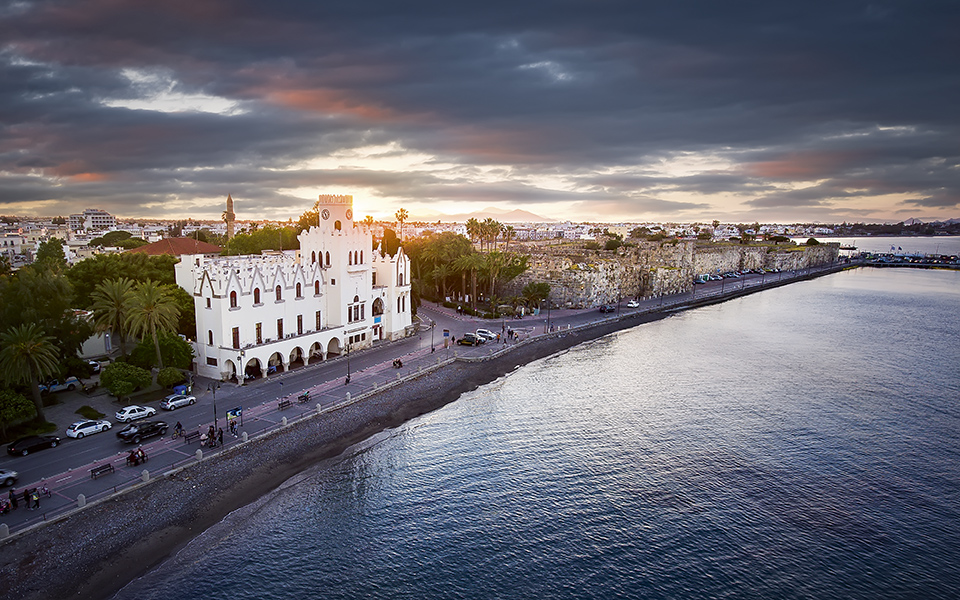What do you love most about Kos Town?” I ask Anna, a friend who lives on the island and is acting as my guide. “I love how easy it is to just wander into the ancient agora or the Roman theatre and soak up centuries of history,” she answers without hesitation. “The whole town is like an open-air archaeological museum. You walk through ancient remains on your way to work, you have a drink in a bar right to the columns of the ancient agora. You really sense that there’s an ancient town right under your feet.” Its antiquities are just one of the reasons why Kos is world-famous – the others being its light and its coastline.
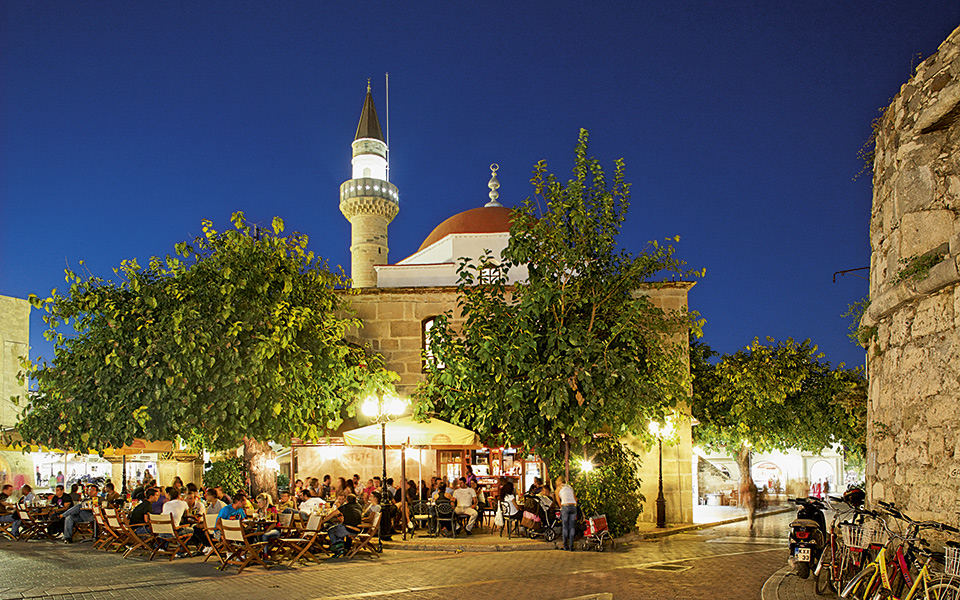
© GettyImages
On Eleftherias Square, I drink Greek coffee brewed the traditional way on the embers in Café Aenaos and people-watch. Kids play football, moms with strollers shop in the beautiful arcades of the municipal market, cats weave between the legs of the old people, while the young play backgammon in the cafés. I watch tourists, map in hand, turn full circle to admire the surrounding buildings: the Defterdar Mosque and its fountain (both from the Ottoman era), the Archaeological Museum (housed in a building dating to the period of Italian rule), and the medieval fortifications.
Kos has been inhabited since the fourth millennium BC, and has changed hands many times over the centuries. Part of its charm is that it lets you see how all these eras are engaged in a lively dialogue in the present. In a single snapshot, it is possible to capture an ancient column, a minaret and an Italianate building. “All the civilizations that passed through here – Romans, Crusaders, Turks, Italians – left their mark. Each built a town on top of the last one,” says Vasilis Hatzivasileiou, a local historian and lawyer.
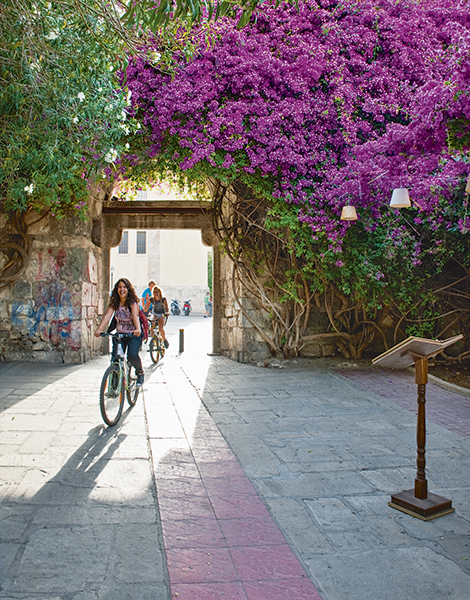
© Shutterstock
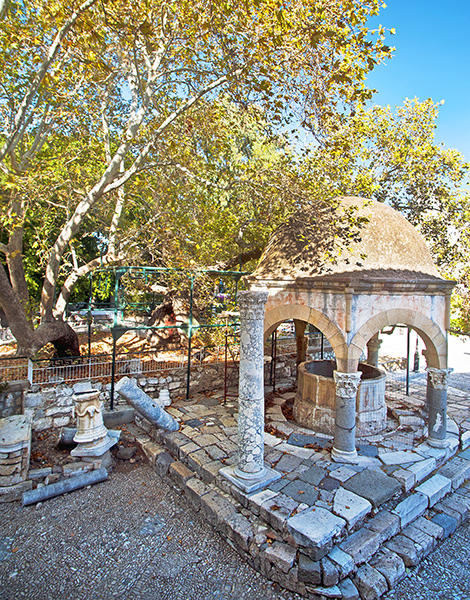
© Shutterstock
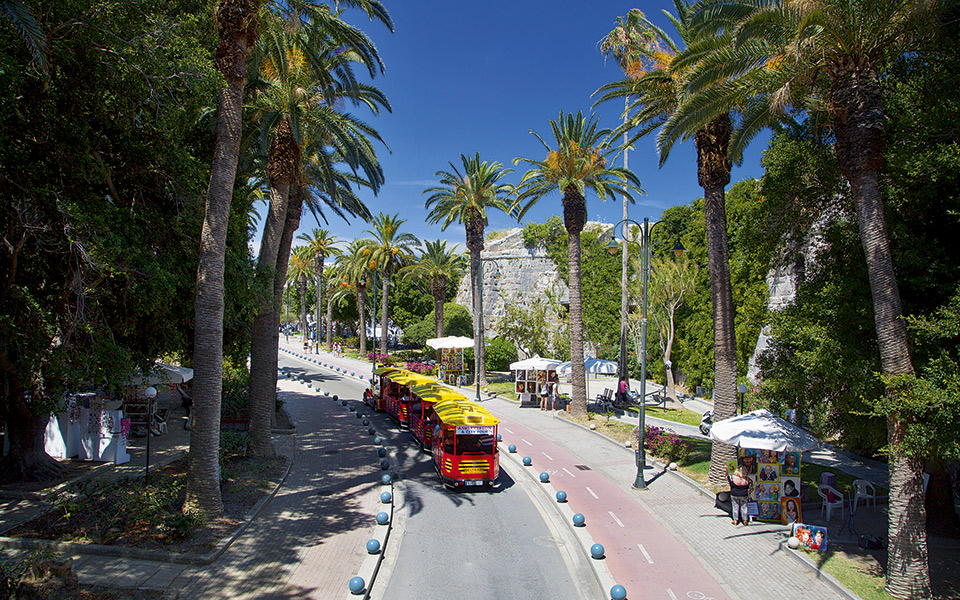
© Olga Charami
AROUND THE ANCIENT AGORA
The roads around Eleftherias Square are pedestrianized. They are lively places, particularly in the evening: street artists rub shoulders with balloon sellers who are trying to avoid the children on bicycles. There are shops, artists’ studios and restaurants serving everything from souvlaki to Chinese food, all coming together to form a multicultural mosaic.
I walk to nearby Kazouli Square to sample a local favorite tyropita (cheese pie) with honey, along with a bougatsa (custard pie) from Tsivrinis (also called Ariston), an authentic Greek kafeneio established in 1952. This is the start of Nafklirou Street, famous for its nightlife: the bars here play Greek or foreign music until dawn and host endless, occasionally wild parties. During the day, it is more tranquil. Down the side streets, you catch glimpses of souvenir shops, low whitewashed houses and tavernas preparing for the dinner service. “Please sit down,” says a waiter laying out the tablecloths, “the sun is strong and this isn’t the time for walking.” The sun is indeed strong, but I decide nevertheless to sneak into the ancient Agora from a side entrance located just here.
This is one of two archaeological parks in the town. The ancient town was built in 366 BC, and its agora, extending over 4 hectares, is one of the largest in the world. “It’s because of the Italians that we can see the site today. Kos was flattened by the great earthquake of 1933, but thanks to the intervention of the Italian Archaeological School, the government of the time decided to preserve the archaeological sites rather than build over them. This is very rare for a Greek city,” says archaeologist Angeliki Giannikouri, a former director of the Archaeological Institute of Aegean Studies. She describes how as a child she played among the ruins, and how as an archaeologist she was active in the program to link up and promote the sites. In the company of several small groups of tourists, I pick my way through the wild plants, under the hot sun, looking for the ruins of the temples of Aphrodite and Heracles, the early Christian basilica of the Port, the arcade, the fortifications and the remains of houses said to measure up to 140 square meters each. A little later, we all go in search of shade.
“In a single snapshot, it is possible to capture an ancient column, a minaret and an Italianate building. All the civilisations that passed through here left their mark.”
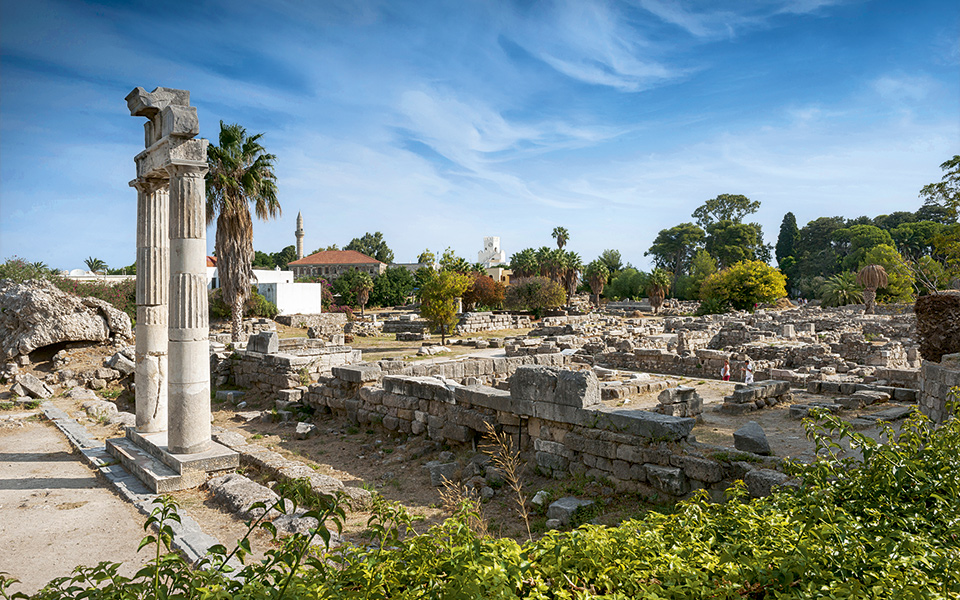
© Giannis Giannelos
KOS UNDER ITALIAN RULE
I exit the agora at Akti Miaouli, where the sea breeze, the view of the Turkish coast and the sound of the street traffic bring me back to the present, or rather the more recent past. This spot is the location of the Knightly Residence of Governor Francesco Sans (built in the 16th century) and the Italian Palazzo del Governo (Government Palace), the most impressive building of the Italian period, built in the late 1920s and incorporating characteristic Italian Eclectic features (it is now a police station). After the 1933 earthquake, the Italian rulers redeveloped Kos and created a master plan for the city. They also conducted excavations and restorations of the monuments, planted the streets and enriched the urban landscape with impressive buildings. Their purpose was to stamp their presence on the island, to restructure public administration and to house new services and settlers. In contrast to their policy in the rest of the Dodecanese, where they erected imposing monumental structures, the Italian buildings in Kos are simpler, and more in keeping with the island’s architectural heritage.
Further examples of the architecture of this period can be seen at the Aktaion Hotel (former Albergo Gelsomino Hotel), the mayor’s residence and the Italian Club. Ahead of me, a group of tourists pause to admire these buildings before heading to the beach for a swim. I don’t follow them, choosing instead to visit the remains of Kos’ Roman past, the past that the Italians aspired to resurrect.
“Τhanks to the intervention of the Italian Archaeological School after 1933 earthquake, the archaeological sites were preserved rather than built over, as happened in so many Greek towns.”
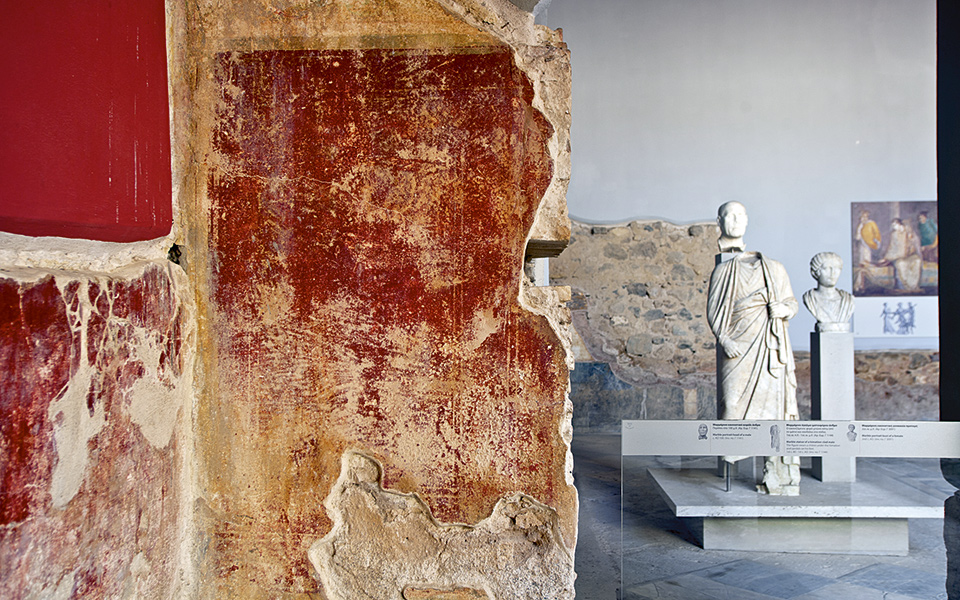
© Clairy Moustafellou
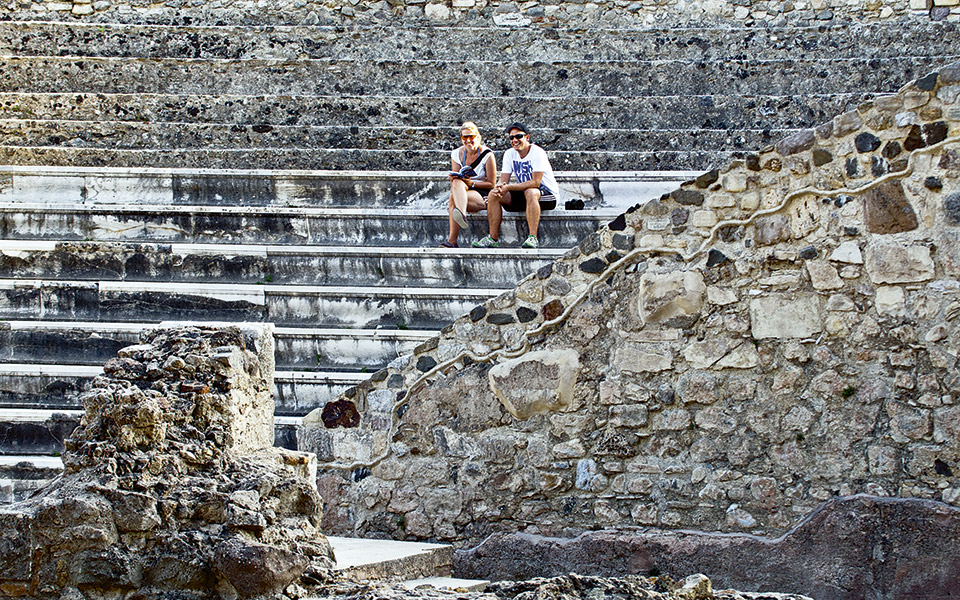
© Clairy Moustafellou
THE ROMAN TOWN
Grigoriou V Street is shaded by rows of trees forming an arch. Here again we see all the periods of Kos’ history in co-existence; the Hellenistic altar to Dionysus, the Roman baths, fragments of an aqueduct and a prosperous residential neighborhood. The highlight is Casa Romana, a luxurious Roman residence spread over 2,400 square meters, whose first phase dates to the Hellenistic period. The building has been restored, and its exhibits illustrate the daily life of the house’s residents.
Also on Grigoriou V Street is the Roman amphitheater, the Odeon. I enjoy sitting in silence on the stone tiers, and make a mental note to come back and enjoy a performance or a concert. Opposite the Odeon is the town’s second archaeological park. It includes remains dating mainly to the Roman period, and is known as the “Western Zone.” I wander around the area near the entrance and spot the murals and mosaics in the house of the Rape of Europa and Silenus, the Thermes, the Hellenistic gymnasium with the Xistos (the stoa where the athletes trained), the ancient stadium, and my personal favorite, the Nymphaion, whose real function was as public lavatories – the latter is impressive not only because of its earthy function, but also because of an excellent restoration job. Although they are not open to the public, the atrium, the colonnade and the mosaic floors can be glimpsed through a window.
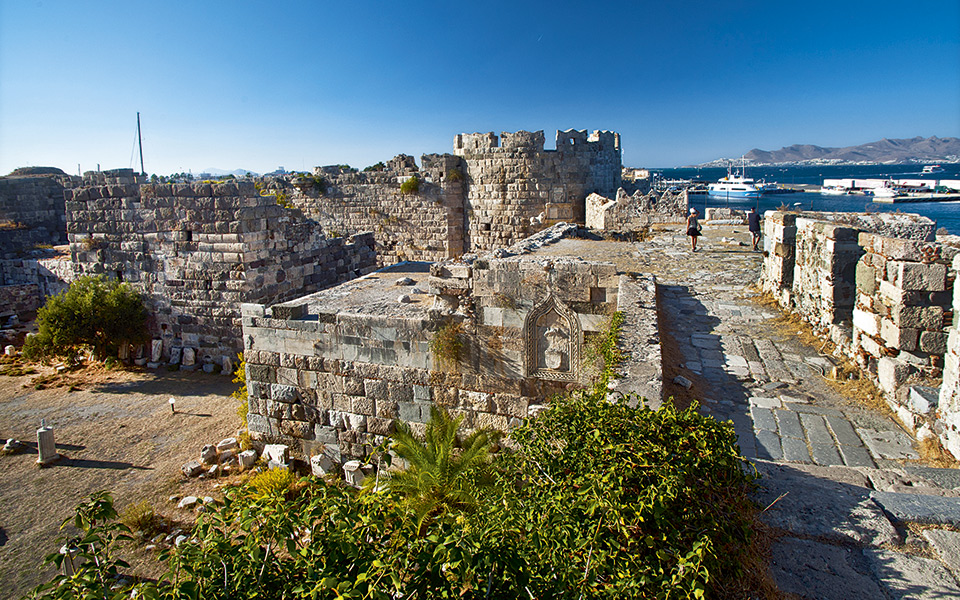
© Clairy Moustafellou
THE COSMOPOLITAN HARBOR
From here I head to the port, on Akti Koundourioti. Here, the action never stops. Souvenir shops share the street with restaurants and more Italian buildings, including the Town Hall. In the harbor, leisure craft, fishing boats and luxury yachts all coexist harmoniously. Some fishermen suggest that I take a ride on the little sightseeing train. Just then, I’m startled by the sound of bells, and I barely have time to step back, narrowly avoiding being mown down by a group of cyclists. I had been standing on the cycle path, which winds along the coast for 13 kilometers.
I cross the pretty green Finikon (or “Palm”) Avenue and walk towards Neratzia Castle. Passing over the bridge and past the towers and battlements, I note the cannon slots, the coats of arms and the ancient architectural fragments built into the walls, including an impressive Hellenistic relief over the main gate. The position was first fortified in the Byzantine period, but was converted into a castle by the Knights of St John at the end of the 14th century. Together with the castle of St Peter in neighboring Bodrum on the Turkish coast, it controlled the sea passage.
My walk concludes in Platanos (“Plane Tree”) Square. Here, time slows down and I see people lingering on the benches, wandering in and out of the tasteful gift shops, pausing in front of the beautiful spring of the Mosque of the Loggia (also known as the Mosque of Gazi Hasan Pasha), or visiting the Turkish bath (hamam), known as the Salt Storehouse. I look up at the big plane tree that gives the square its name. Legend has it that it’s 2,300 years old and gave its shade to Hippocrates – in fact, plane trees rarely survive beyond 500 years. I smile as I remember how the British writer Lawrence Durrell described his visit to this very spot in the last century: “I slept under the tree for two nights,” he wrote, “hoping that the spirit of the old god-physician might confer some of his healing powers upon me, but it was winter and all I achieved was a touch of rheumatism.”

